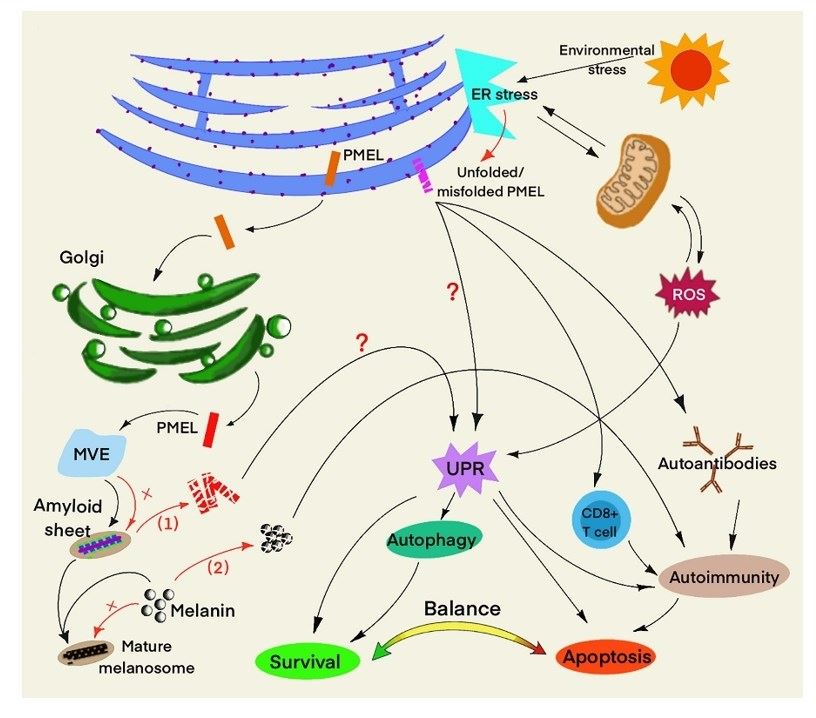What is PMEL Protein
PMEL, or Premelanosome Protein, is a fascinating molecule that plays a crucial role in the process of melanin biosynthesis. Also known by its official full name, Pmel17, and various synonyms such as Silver locus protein homolog and Melanocyte protein PMEL, this protein is a member of the Pmel family. Structurally, it exhibits unique characteristics, boasting a long N-terminal region, rich in proline, serine, and threonine residues, which is crucial for its function.
Classified as a melanosome matrix protein, PMEL has garnered significant attention in recent research advances. Scientists have made strides in unraveling its intricate structure and understanding its role in melanogenesis—the complex biological process responsible for the production of melanin pigments.
PMEL Biological Functions and Molecular Mechanisms
The biological functions of PMEL are intricately tied to the pigmentation of tissues, primarily through melanin production. Within melanocytes—the specialized cells responsible for melanin synthesis—PMEL orchestrates the formation of melanosomes, the cellular compartments where melanin pigments are generated and stored.
At a molecular level, PMEL acts as a scaffold for the polymerization of melanin within these melanosomes. It guides the deposition of melanin on its surface, facilitating the creation of the characteristic structures known as fibrils. This process is crucial for determining the coloration of tissues, skin, and hair, making PMEL a key player in the aesthetics of diverse organisms.

Figure 1. The mechanism of damaged PMEL/UPR-TRP channels/autophagy axis system in vitiligo. (Xie B, et al., 2022)
PMEL Related Signaling Pathway
The molecular pathway associated with PMEL function is intricate, involving a cascade of events within melanocytes. Signal pathways, such as those involving protein kinase A (PKA) and protein kinase C (PKC), play a crucial role in regulating PMEL and, subsequently, melanin biosynthesis.
Upon activation, PMEL undergoes proteolytic cleavage, leading to the formation of fragments that contribute to melanin polymerization. These events are tightly regulated, and any disturbances in the delicate balance of signaling cascades can result in pigmentary disorders.
PMEL Related Diseases
While PMEL is pivotal for normal pigmentation, abnormalities in its function can lead to a spectrum of disorders. One such condition is dyschromatosis symmetrica hereditaria (DSH), a genetic disorder characterized by distinctive skin pigmentation patterns. Mutations in the PMEL gene can disrupt melanin production, resulting in the telltale skin discolorations seen in individuals with DSH.
Understanding these diseases at a molecular level, particularly the aberrations in PMEL function, opens avenues for potential therapeutic interventions and diagnostic strategies.
PMEL's Applications in Biomedicine
The unique properties of PMEL have found applications beyond the realm of pigmentation studies. In the field of diagnostics development, researchers are exploring the potential of PMEL as a biomarker for melanoma, a type of skin cancer. Detecting PMEL levels in blood or tissues could serve as an early indicator of melanoma, allowing for timely intervention and improved prognosis.
In vaccine development, PMEL is being investigated for its ability to stimulate immune responses. Leveraging its role in melanin biosynthesis, researchers are exploring the use of PMEL-derived peptides to develop vaccines against melanoma. This innovative approach holds promise for developing targeted and effective immunotherapies.
In the realm of therapeutics, the potential of PMEL extends to the treatment of pigmentary disorders. By modulating the activity of PMEL or developing compounds that target its signaling pathways, researchers aim to correct aberrations in melanin production and offer novel therapeutic strategies for conditions like dyschromatosis symmetrica hereditaria.
Recommended Products
| Cat.# | Product name | Species | Source (Host) | Tag |
|---|---|---|---|---|
| PMEL-190H | Recombinant Human PMEL protein, MYC/DDK-tagged | Human | HEK293 | Myc/DDK |
| PMEL-30194TH | Recombinant Human PMEL | Human | E.coli | N/A |
| PMEL-191H | Recombinant Human PMEL Protein, GST-tagged | Human | Wheat Germ | GST |
| PMEL-1518H | Recombinant Human PMEL Protein (25-467 aa), His-tagged | Human | Yeast | His |
| PMEL-3492H | Recombinant Human PMEL protein, His-SUMO-tagged | Human | E.coli | His-SUMO |
| PMEL-2601H | Recombinant Human PMEL Protein, His-tagged | Human | E.coli | N-His |
| PMEL-1717H | Recombinant Human PMEL Protein, His (Fc)-Avi-tagged | Human | HEK293 | His (Fc)-Avi |
| PMEL-6849HF | Recombinant Full Length Human PMEL Protein, GST-tagged | Human | In Vitro Cell Free System | GST |
| PMEL-01H | Recombinant Human PMEL Protein, Tag Free | Human | E.coli | Tag Free |
| PMEL-835HFL | Recombinant Full Length Human PMEL Protein, C-Flag-tagged | Human | Mammalian cells | Flag |
Reference
- Xie B, Song X. The impaired unfolded protein‐premelanosome protein and transient receptor potential channels‐autophagy axes in apoptotic melanocytes in vitiligo. Pigment Cell & Melanoma Research. 2022, 35(1): 6-17.

